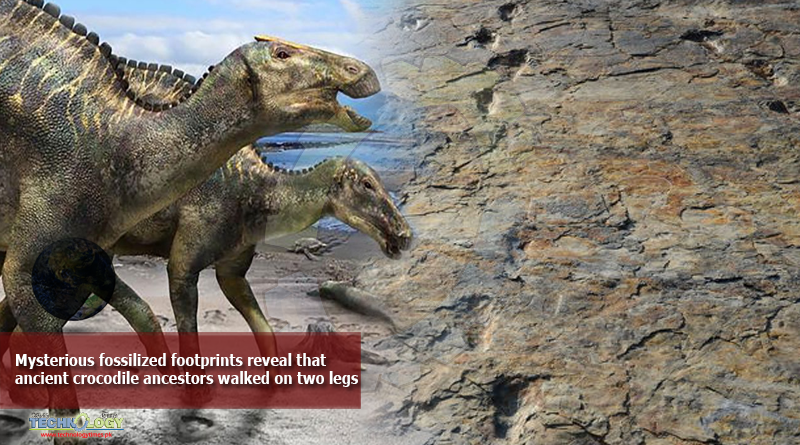Paleontologists discovered a trackway of fossilized footprints in South Korea that are more than 110 million years old.The footprints came from a 10-foot-long crocodile ancestor called a crocodylomorph, which walked only on its hind legs.

Paleontologists in South Korea recently found a trackway of fossilized footprints more than 110 million years old. The tracks were in almost a straight line, and revealed that the prehistoric creature that made them was bipedal — it lumbered around on two legs, not four.
But the shape and weight distribution of the prints suggested that they didn’t belong to a dinosaur.
According to a study published Thursday, the tracks were made by an unexpected animal: a crocodile ancestor called a crocodylomorph that walked upright on two hind legs.
Earlier crocodylomorphs were quadrupeds — they used all their limbs to amble around — so the study authors knew they had stumbled across a new species. They named it Batrachopus grandis.
“People tend to think of crocodiles as animals that don’t do very much; that they just laze around all day on the banks of the Nile or next to rivers in Costa Rica. Nobody automatically thinks I wonder what this creature would be like if it was bipedal and could run like an ostrich or a T. rex,” Martin Lockley, one of the study authors, told BBC News.
Bipedal crocodile-like creatures
Lockley and his colleagues discovered nearly hundreds of these tracks in 2019 outside Sacheon City, South Korea. During the early Cretaceous period, this region of the world was replete with lakes. Creatures like Batrachopus grandis left their footprints along the muddy shores, where many were preserved.
The tracks’ size (between 7 and 9 inches long) indicated that these crocodylomorphs were nearly 10 feet long.
The narrowness of the trackway helped Lockley’s groups conclude that these creatures were walking exclusively on their back legs. They found no evidence of forelimb tracks.
“Our trackways are very narrow-looking — more like a crocodile balancing on a tight-rope,” another study author, Kyung Soo Kim, told BBC News. “When combined with the lack of any tail-drag marks, it became clear that these creatures were moving bipedally.”
The Batrachopus also seem to have walked with a heel-to-toe gait — a bit like humans do — so they left a distinct heel impression in the mud, according to the researchers. Those heel impressions support the idea of a more upright posture, Kim said.
Bipedal dinosaurs walked upright as well, but Kim said dinosaurs (and birds) walked on their toes, which would leave tracks without a heel impression.
Solving an old mystery
The discovery of this ancient croc species has helped put an old paleontological mystery to rest.
At the time, the paleontologists thought the footprints could have been made by pterosaurs— prehistoric flying reptiles — that scuttled on their hind feet when not flying.
But that hypothesis went against most paleontological evidence, which suggested pterosaurs walked on all four limbs when on the ground.
Now Lockley and Kim think they’ve figured out which animal made those other tracks: a bipedal crocodylomorph, perhaps from this same newly discovered species.
Originally Publish at: https://www.businessinsider.com/
